Uber Eats
Uber Eats is an American online food ordering and delivery platform launched by Uber in 2014 and based in San Francisco, California.[3]
| Industry | Online food ordering |
|---|---|
| Founded | August 2014 |
| Founders | Travis Kalanick, Garrett Camp |
| Headquarters | San Francisco, California, U.S. |
Area served | 45 countries, 6000+ cities |
Key people | Dara Khosrowshahi (CEO)[1] |
| Revenue | |
| Owner | Uber |
| Website | ubereats |
History
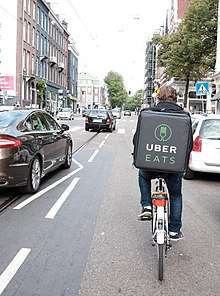

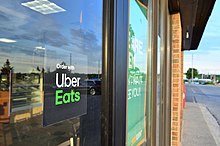
Uber Eats' parent company Uber was founded in 2009 by Garrett Camp and Travis Kalanick.[4][5] The company began food delivery in August 2014 with the launch of the UberFRESH service in Santa Monica, California.[6] In 2015, the platform was renamed to UberEATS,[7] and the ordering software was released as its own application, separate from the app for Uber rides.[8][9] Its London operation opened in 2016.[10]
In August 2018, Uber Eats changed its flat $4.99 delivery fee to a rate that is determined by distances.[11] The fee ranges from a $2 minimum to an $8 maximum.[12] In the UK and Ireland, the delivery fee is based on the value of the order. In February 2019, Uber Eats announced that it would reduce its fee from 35 percent of the order's value to 30 percent.[13] As part of its expansion into foreign markets, the company announced its intention to open virtual restaurants in the UK.[14] Sometimes called cloud restaurants or cloud kitchens, these are restaurant kitchens staffed to prepare and deliver food, either for existing brick-and-mortar restaurants wishing to move their delivery operations offsite, or for delivery-only restaurants with no walk-in or dining room service.[15]
In November 2018, the company announced plans to triple its workforce in its European markets. As of November 2018, the company reported making food deliveries in 200 cities in 20 countries in EMEA markets.[10]
In 2019, Uber Eats said it would deliver food to customers by drones from the Northern Hemisphere summer of 2019,[16] and partnered with Apple on the release of the Apple Card.[17] In July, Uber Eats began offering a dine-in option in certain cities that allowed customers to order food ahead of time and then eat in the restaurant.[18]
September 2019, Uber Eats said it would leave the South Korea market, with Reuters attributing this to the amount of competition for food delivery companies in Korea.[19] In October, the company launched a pick-up option.[20] On October 15, 2019, the company said it would deliver Burger King fast food throughout the United States.[21]
On January 21, 2020, Zomato said it would acquire all of Uber Eats's stock in India. As part of the deal, Uber would own 9.99% stake in Zomato and Zomato would gain all the users of Uber Eats in India.[22] At the time of the deal, Zomato was valued at roughly $3.55 billion.[23]
On January 28, 2020 it was reported that Uber Eats no longer had exclusive delivery rights for McDonald's in the United Kingdom, as the fast food company had partnered with British-based food-delivery company Just Eat.[24] The company had already lost its exclusive delivery rights with McDonald's in the United States the year before.[25]
In March 2020, during the COVID-19 pandemic, Uber Eats saw a 30% rise in new customers.[26]
On May 4, 2020 Uber Eats announced they were exiting the United Arab Emirates and that the service would now be through Dubai based vehicle for hire company Careem. The same report stated they were also exiting Saudi Arabia and Egypt.[27]
By mid 2020, in the middle of the coronavirus pandemic where demand for services delivering food from restaurants and takeaways surged, it got even worse for Uber Eats, who announced plans to let go around 20% of its workforce, some 5,400 roles.[28] The company’s nominal reasoning for needing cuts is that coronavirus will be followed by an economic downturn, which could hit orders.[29]
Operation
Users can read menus, reviews and ratings, order, and pay for food from participating restaurants using an application on the iOS or Android platforms, or through a web browser.[30] Users are also able to tip for delivery.[31] Payment is charged to a card on file with Uber.[32] Meals are delivered by couriers using cars, scooters, bikes, or on foot.[33]
Controversy and criticism
During the COVID-19 pandemic, Uber Eats has been criticised for charging struggling fast food restaurants 30% to 35% commission.[34][35]
Ratings and reviews
As of 2020, Uber Eats' rating with the BBB is "NR" or "No Rating".[36]
Allegations of monopolistic behavior
In April 2020, a group of New Yorkers sued Uber Eats along with DoorDash, GrubHub, Postmates, accusing them of using their market power monopolistically by only listing restaurants on their apps if the restaurant owners signed contracts which include clauses that require prices be the same for dine-in customers as for customers receiving delivery.[37][38][39][40] The plaintiffs state that this arrangement increases the cost for dine-in customers, as they are required to subsidize the cost of delivery; and that the apps charge “exorbitant” fees, which range from 13% to 40% of revenue, while the average restaurant’s profit ranges from 3% to 9% of revenue.[37][38][39][40] The lawsuit seeks triple damages, including for overcharges, since April 14, 2016 for dine-in and delivery customers in the United States at restaurants using the defendants’ delivery apps.[37][38][39][40] The case is filed in the federal U.S. District Court, Southern District of New York as Davitashvili v GrubHub Inc., 20-cv-3000.[41][37][38][39][40] Although a number of preliminary documents in the case have now been filed, a trial date has not yet been set.[42]
All Countries

.svg.png)
.svg.png)

.svg.png)


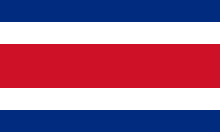

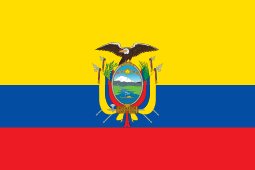


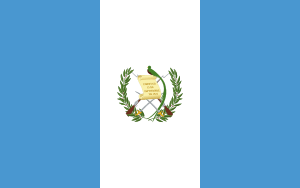





















See also
References
- Bhuiyan, Johana (June 4, 2018). "Uber CEO Dara Khosrowshahi says UberEats has a $6 billion bookings run rate". Recode. Retrieved October 3, 2018.
- "Uber Eats revenue". Craft. Retrieved December 9, 2019.
- Wright, Johnathan L. (September 5, 2017). "Uber Eats debuts Wednesday in Reno". Reno Gazette Journal. Retrieved September 5, 2017.
- Lagorio-Chafkin, Christine (August 2013). "Resistance is Futile". Inc. Retrieved March 22, 2019.
- Bacon, James (February 2, 2012). "BACON: Innovation Uber alles". The Washington Times. Retrieved September 11, 2015.
- Etherington, Darrell (August 26, 2014). "Uber Begins Testing Lunch Delivery With UberFRESH". Tech Crunch. Retrieved June 2, 2015.
- Elliott, Farley (May 4, 2015). "UberFRESH Rebrands to UberEATS Just in Time to Expand Like Crazy". Eater. Retrieved September 11, 2015.
- Kosoff, Maya (August 17, 2015). "How Uber's latest update could pose a major threat to GrubHub". Business Insider. Retrieved September 11, 2015.
- Tepper, Fitz (August 17, 2015). "Uber's New Update Gives Food Delivery As Much Attention As Transportation". TechCrunch. Retrieved September 11, 2015.
- Turner, Gilles (November 6, 2018). "Uber Plans to Triple Headcount on Food Delivery in Europe Region". Bloomberg. Bloomberg LP. Retrieved May 29, 2019.
- Lee, Dami (August 8, 2018). "Uber Eats is changing its flat fees to delivery fees based on distance". The Verge. Retrieved August 9, 2018.
- Kerr, Dara (August 8, 2018). "Uber Eats gets a little cheaper and a little more expensive". CNET. Retrieved August 9, 2018.
- Ram, Aliya; Bond, Shannon (February 20, 2019). "Uber Eats to cut fees in battle with Deliveroo and Just Eat". FT.com. THE FINANCIAL TIMES LTD. Retrieved May 29, 2019.
- Field, Matthew; Rudgard, Olivia (October 15, 2018). "Uber Eats eyes 400 'virtual restaurants' as it takes fight to Deliveroo". Daily Telegraph. Telegraph Media Group. Retrieved May 29, 2019.
- Holmes, Mona (May 23, 2018). "Here's Why a Lot of Delivery Food Isn't Coming From Actual Restaurants". LA.Eater.com. Vox Media. Retrieved May 29, 2019.
- "Uber Eats To Test Flying Food To Customers By Drone In San Diego". Forbes.com. Forbes. June 12, 2018. Retrieved June 17, 2019.
- "Apple Card launches today for all US customers, adds 3% cash back for Uber and Uber Eats". TechCrunch. Retrieved August 23, 2019.
- "Uber Eats invades restaurants with Dine-In option". TechCrunch. Retrieved December 13, 2019.
- "Uber Eats to pull out of South Korea amid tough competition". Reuters. September 9, 2019. Retrieved February 8, 2020.
- Tyko, Kelly. "Uber Eats launches delivery alternative with new pickup feature". USA TODAY. Retrieved December 13, 2019.
- "Amid Layoffs, Uber Eats Partners with Burger King". The Spoon. October 15, 2019. Retrieved February 8, 2020.
- "Uber sells food delivery business in India to Zomato". TechCrunch. Retrieved January 21, 2020.
- Goel, Vindu; Conger, Kate (January 20, 2020). "Uber Sells Food Delivery Business in India". The New York Times. ISSN 0362-4331. Retrieved February 8, 2020.
- Business, Hanna Ziady, CNN. "Uber suffers another blow as it loses McDonald's delivery monopoly in the UK". CNN. Retrieved February 8, 2020.
- "McDonald's UK taps Just Eat for delivery, ends Uber Eats exclusivity". Restaurant Dive. Retrieved February 8, 2020.
- Chiappetta, Marco. "Uber Eats Demand Soars Due To COVID-19 Crisis". Forbes. Retrieved March 31, 2020.
- "Uber Eats decides to switch off in UAE". Gulf News. Retrieved May 15, 2020.
- Ball, James (May 2, 2020). "Deliveroo was the poster child for venture capitalism. It's not looking so good now". The Guardian.
- Ball, James (May 2, 2020). "Deliveroo was the poster child for venture capitalism. It's not looking so good now". The Guardian.
- Mogg, Trevor (March 15, 2016). "Uber enters the food delivery game". Digital Trends. Retrieved October 15, 2016.
- "Uber Vs. Seamless & GrubHub: How To Order Food Via Uber Eats In New York, Chicago & Los Angeles". iDigitalTimes. Archived from the original on May 1, 2015. Retrieved September 18, 2015.
- Frost, Peter (April 28, 2015). "Uber launches lunch-delivery service in Chicago". Chicago Business. Retrieved September 18, 2015.
- Said, Carolyn (August 18, 2015). "UberEats comes to S.F., offering meal deliveries". SF Gate. Retrieved September 19, 2015.
- Batey, Eve (April 3, 2020). "Delivery Apps Refuse to Temporarily Decrease the Fees They Charge Restaurants". Eater SF. Retrieved July 1, 2020.
- Fickenscher, Lisa; Manskar, Noah (July 1, 2020). "Uber Eats cuts fees for NYC restaurants as Grubhub rivalry heats up". New York Post. Retrieved July 1, 2020.
- "Uber Technologies | Reviews | Better Business Bureau® Profile". www.bbb.org. Retrieved May 29, 2020.
- Allyn, Bobby (May 14, 2020). "Restaurants Are Desperate — But You May Not Be Helping When You Use Delivery Apps". NPR. Archived from the original on May 17, 2020. Retrieved May 20, 2020.
Frank points to a clause in the contracts restaurants and the food delivery apps agree to that prohibits owners from charging delivery customers more than people who dine in, even though delivery costs more. "By not forcing those purchasing on apps to bear the whole amount of the fees, instead forcing all menu prices to rise together, in-restaurant diners are effectively subsidizing Grubhub's high rates," said Frank, who argues such an arrangement is anti-competitive and illegal.
- Baron, Ethan (April 14, 2020). "DoorDash, Uber Eats, Grubhub and Postmates make restaurant meals cost more: lawsuit - Four firms' rise has 'come at great cost to American society,' suit claims". Mercury News. Archived from the original on April 20, 2020. Retrieved May 19, 2020.
Each of the firms uses “monopoly power” to prevent competition, limit consumer choice and force restaurants to agree to illegal contracts that have “the purpose and effect of fixing prices,” the suit claimed. ... The four companies give restaurants a “devil’s choice” that requires them to keep dine-in prices the same as delivery prices if they want to be on the app-based delivery platforms, the suit claimed. And restaurants must pay commissions to the delivery firms ranging from 13.5% to 40%, the suit alleged. ... Establishments are forced to “calibrate their prices to the more costly meals served through the delivery apps,” the suit alleged.
- Stempel, Jonathon (April 13, 2020). "Grubhub, DoorDash, Postmates, Uber Eats are sued over restaurant prices amid pandemic". Reuters. Archived from the original on April 17, 2020. Retrieved May 19, 2020.
GrubHub, DoorDash, Postmates and Uber Eats were sued on Monday for allegedly exploiting their dominance in restaurant meal deliveries to impose fees that consumers ultimately bear through higher menu prices, including during the coronavirus pandemic. In a proposed class action filed in Manhattan federal court, three consumers said the defendants violated U.S. antitrust law by requiring that restaurants charge delivery customers and dine-in customers the same price, while imposing “exorbitant” fees of 10% to 40% of revenue to process delivery orders. The consumers, all from New York, said this sticks restaurants with a “devil’s choice” of charging everyone higher prices as a condition of using the defendants’ services.
- Dolmetsch, Chris (April 13, 2020). "GrubHub, Doordash Accused in Suit of Pushing Prices Higher". Bloomberg News. Archived from the original on April 19, 2020. Retrieved May 19, 2020.
The New York customers, who seek class-action status, say the delivery services charge “exorbitant fees” that range from 13% to 40% of revenue, while the average restaurant’s profit ranges from 3% to 9% of revenue, making delivery meals more expensive for eateries. “Restaurants could offer consumers lower prices for direct sales, because direct consumers are more profitable,” the plaintiffs said. “This is particularly true of dine-in consumers, who purchase drinks and additional items, tip staff, and generate good will.”
- Davitashvili v GrubHub Inc., Link from NPR article (2020).
- "Court Listener". July 28, 2020. Retrieved July 28, 2020.